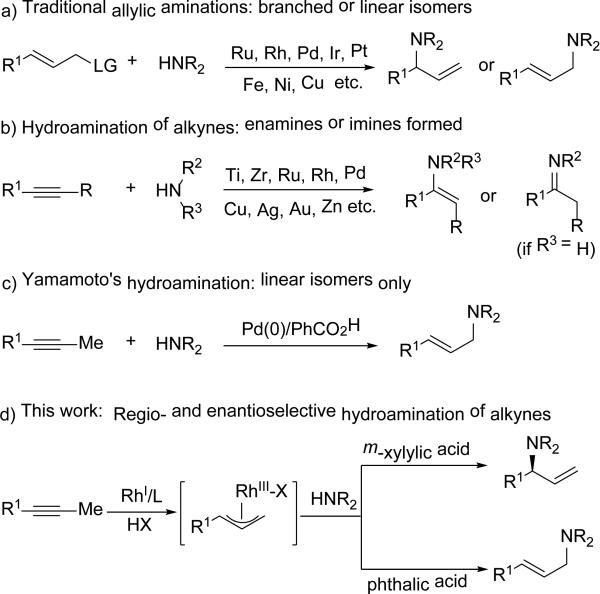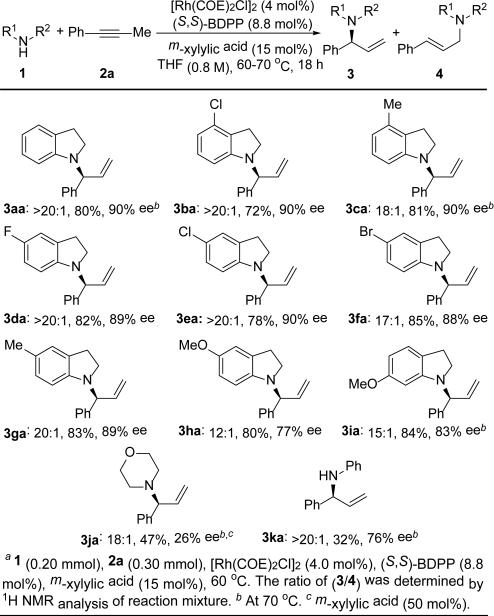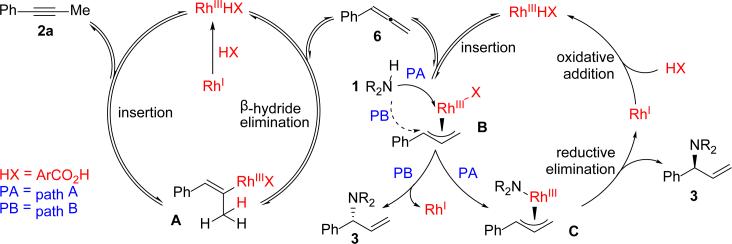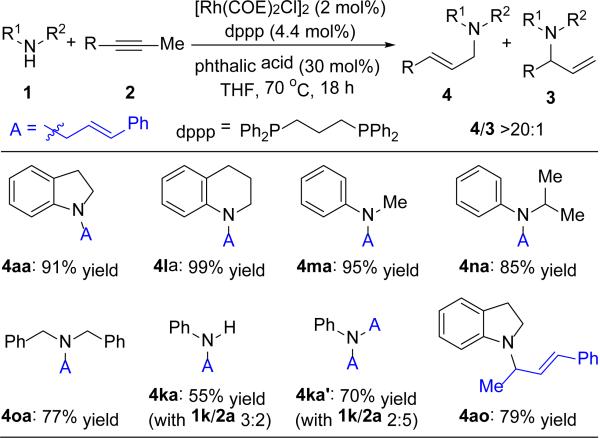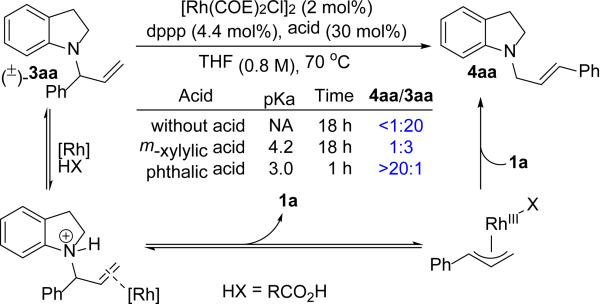Abstract
The hydroamination of internal alkynes via tandem rhodium-catalysis gives branched N-allylic indolines with high regio- and enantioselectivity. An acid-switch provides access to the linear isomer in preference to the branched isomer by an isomerization mechanism. Mechanistic studies suggest formation of an allene intermediate, which undergoes hydroamination to generate allylic amines instead of the enamine or imine products typically observed in alkyne hydroaminations.
Constructing C–N bonds with high regio- and enantiocontrol represents an important challenge given the occurrence of amines in agrochemicals, fine-chemicals, and pharmaceuticals. Transition-metal catalysis has enabled the coupling of amines with allylic-electrophiles to provide either the branched or linear isomers (Figure 1a).1 The hydroamination of alkynes has emerged as an attractive approach for C–N bond formation because of its high atom economy.2 The majority of metal-catalysts investigated provide enamine or imine products (Figure 1b). In contrast, Yamamoto demonstrated a Pd-catalyzed hydroamination of internal alkynes to yield allylic amines, with preference for the linear isomers (Figure 1c).3 While a promising approach, no intermolecular variants have been shown to access the corresponding branched isomers. Herein, we demonstrate a Rh-catalyzed alkyne hydroamination4 that allows access to either the branched or linear isomers, with high regiocontrol by choice of carboxylic acid additive (Figure 1d). This communication showcases the first enantioselective intermolecular hydroamination of alkynes.
Figure 1.
Allylic Aminations versus Alkyne Hydroaminations
Late transition-metal hydrides (e.g., Ru, Rh, Ir, Pd) are known to convert alkynes to π-allyl metal intermediates. Since Yamamoto's report,3 Ishii,5 Krische,6 and our group7 have used metal-hydride catalysis to couple internal alkynes with alcohols or aldehydes to generate C–C bonds. The Breit group pioneered the use of terminal alkynes to form allylrhodium intermediates that undergo C–O and C–S bond formations.8 Encouraged by this emerging concept, we focused on the functionalization of alkynes to generate C–N bonds with both regio- and enantiocontrol.
To test our hypothesis, we chose the coupling of indoline 1a and 1-phenyl-1-propyne 2a as model substrates (Table 1). Commercially available metal hydride complexes (e.g., RuHCl(CO)(PPh3)3, RhH(CO)(PPh3)3, or IrH(CO)(PPh3)3) did not promote hydroamination. In contrast, a mix of [Rh(COE)2Cl]2/L1 and benzoic acid8 afforded the desired branched indoline 3aa in trace amounts (4% yield, entry 1).9 More electron rich and bulky ligands L2 and L3 improved reactivity and gave high regioselectivities (3aa/4aa) and moderate enantioselectivities (47-55% ee, entries 2-3). Among the bidentate phosphines bearing point chirality that we studied, (S,S)-BDPP L6 gave the most promising regio- and enantioselectivity (87% ee, entry 6). We assume this ligand shows enhanced reactivity and selectivity due to its ability to promote isomerization and hydroamination in parallel. In the absence of acid, no hydroamination was observed. By investigating other acid additives, we found higher enantioselectivity using m-xylylic acid (90% ee, entry 7).
Table 1.
Ligand Effects on Hydroamination of Alkynea

| ||||
|---|---|---|---|---|
| entry | ligand | 3aa/4aa b | yield of 3aa (%)b | ee (%)c |
| 1 | L1 | >20:1 | 4 | ND |
| 2 | L2 | 19:1 | 18 | 55 |
| 3 | L3 | >20:1 | 64 | 47 |
| 4 | L4 | 5:1 | 2 | ND |
| 5 | L5 | 4:1 | 57 | 47 |
| 6 | L6 | >20:1 | 62 | 87 |
| 7d | L6 | >20:1 | 80e | 90 |
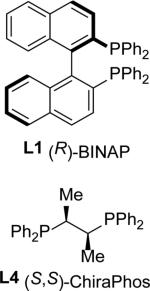
|

|
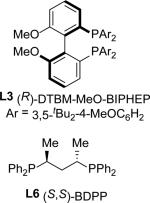
|
||
1a (0.10 mmol), 2a (0.12 mmol), [Rh(COE)2Cl]2 (2 mol%), Ligand (4.4 mol%),PhCO2H (30 mol%), THF (0.25 mL), 70 °C, 18 h.
Determined by 1H NMR or GC-FID with 1,3,5-trimethoxybenzene as the internal standard, ND = not determined.
Determined by chiral SFC.
1a (0.20 mmol), 2a (0.30 mmol), [Rh(COE)2Cl]2 (4 mol%), (S,S)-BDPP (8.8 mol%), m-xylylic acid (15 mol%).
Isolated yield.
With this protocol in hand, we explored the hydroamination of alkyne 2a with various amines 1 (Table 2). Good yields (72% and 81%) and high enantioselectivities (90% ee) were obtained using indolines with varying substituents at the 4-position (3ba and 3ca). Substrates bearing fluoro, chloro, and bromo at the 5-position were transformed into allylic amines with similar efficiency (3da-3fa). A slight decrease in enantioselectivity was observed with indolines containing electron-donating substituents at the 5- or 6-position (3ga vs 3ha, 3ia). In contrast, an aliphatic amine, such as morpholine, showed poor reactivity under this protocol (8% yield, 3ja). An improved yield (47%, 3ja) could be obtained by using more m-xylylic acid (50 mol%). Aniline 1k was coupled with alkyne 2a in good selectivity (>20:1 b/l, 76% ee, 3ka) without bisallylation. In all cases, we observed excellent regioselectivity for the branched isomers in preference to the linear isomers.
Table 2.
Branched-Selective Hydroamination with Various Aminesaa
Next, we examined the scope of alkynes (Table 3). The use of electron rich 1-aryl-1-propynes 2b-c gave branched allylic amines in >20:1 regioselectivities, 70-73% yields, and 82-91% ee (entries 1-2). Although a decrease in regioselectivity (from 20:1 to 3:1) was observed with electron deficient alkynes 2d-g, high enantioselectivities (86-92%) were still achieved (entries 3-6). The coupling of indoline with meta-substituted 1-phenyl-1-propynes 2h-j gave a slight increase in enantioselectivity (90-94%, entries 7-9). This protocol tolerated a heterocycle-substituted alkyne 2k (80% yield, entry 10). However, low reactivity (15% yield) and selectivity (27% ee) were obtained using the internal alkyne 2l bearing an aliphatic group (entry 11). The hydroamination of terminal alkyne 2m gave the same product as that of 2a, with similar regioselectivity and enantioselectivity but lower reactivity (entry 12). Poor enantioselectivity (7%) was observed in the hydroamination of 1-octyne 2n (entry 13).10 These results suggest that an aromatic substituent on alkyne 2 is critical for high yield and selectivity.
Table 3.
Branched-Selective Hydroamination of Various Alkynesa

| ||||
|---|---|---|---|---|
| entry | R1/R2 in 2 | 3/4 | y ield (%)b | ee (%)b |
| 1 | 4-MeC6H4/Me (2b) | >20:1 | 73 | 91 (3ab) |
| 2c | 4-MeOC6H4/Me (2c) | >20:1 | 70 | 82 (3ac) |
| 3 | 4-FC6H4/Me (2d) | 20:1 | 87 | 90 (3ad) |
| 4 | 4-ClC6H4/Me (2e) | 11:1 | 83 | 92 (3ae) |
| 5 | 4-BrC6H4/Me (2f) | 5:1 | 69 | 86 (3af) |
| 6 | 4-CF3C6H4/Me (2g) | 3:1 | 70 | 91 (3ag) |
| 7 | 3-MeC6H4/Me (2h) | >20:1 | 79 | 90 (3ah) |
| 8 | 3-FC6H4/Me (2i) | 11:1 | 82 | 94 (3ai) |
| 9 | 3-ClC6H4/Me (2j) | 8:1 | 81 | 93 (3aj) |
| 10 | 3-Thienyl/Me (2k) | 7:1 | 80 | 65 (3ak) |
| 11c | Cy/Me (2l) | 2:1 | 15 | 27 (3al) |
| 12c | Bn/H (2m) | 19:1 | 37 | 89 (3aa) |
| 13c | n-C6H13/H (2n) | 7:1 | 29 | 7 (3an) |
1a (0.20 mmol), 2 (0.30 mmol), [Rh(COE)2Cl]2 (4.0 mol%), (S,S)-BDPP (8.8 mol%), m-xylylic acid (15 mol%), THF (0.25 mL), 60 °C. The ratio of 3/4 was determined by 1H NMR analysis of reaction mixture.
Isolated yield and ee of 3.
At 70 °C.
A one-pot protocol was developed, using Rh-catalyzed asymmetric hydroamination and subsequent oxidative dehydroaromatization of indolines 3, to provide facile access to N-allylic indoles11 5aa (90% ee) and 5ba (85% ee) (eq. 1). The absolute configuration of 5aa was determined to be (S) by comparison of its optical rotation with literature data.11c-d,12
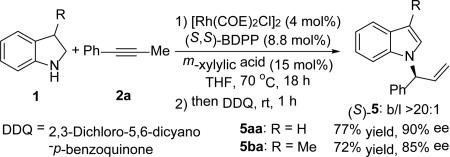 |
(1) |
During our optimization studies, we found that using phthalic acid (benzene-1,2-dicarboxylic acid)13 instead of m-xylylic acid gave linear allylic amines with high regioselectivity (>20:1). A number of amines are suitable coupling partners (4aa, 4la-4oa). By tuning the stoichiometry of aniline 1k (PhNH2) and alkyne 2a, either monoallylated product 4ka or bisallylated product 4ka’ could be formed exclusively. This protocol can be applied to 1-phenyl-1-butyne 2n, which bears an ethyl group, to generate allylic amine 4ao.
On the basis of literature1,8 and our observations, we propose a pathway involving tandem Rh-catalysis (Figure 2). The oxidative addition of carboxylic acid with Rh(I) precursor generates a rhodium (III)-hydride species. The insertion of alkyne 2a into the Rh(III)–H gives Rh-vinyl intermediate A, which subsequently undergoes β-hydride elimination to form intermediate allene 6 and regenerate the Rh(III)–H species. Reinsertion of the terminal allene 6 into Rh(III)–H yields a chiral π-allyl rhodium complex B. Two competing pathways can be considered for formation of product 3.14 For path A, a ligand exchange of amine 1 with the benzoate (X) on complex B will give π-allyl rhodium species C, which can undergo reductive elimination to yield allylic amine 3. In path B, amine 1 undergoes nucleophilic attack at the carbon center to deliver allylic amine 3.
Figure 2.
Tandem Rh-Catalysis: Proposed Mechanism for Hydroamination of Alkynes
To support the proposed allene intermediate, phenylallene 6 was prepared and then subjected to coupling with indoline 1a under otherwise standard conditions (eq. 2).15 Only a trace amount of the expected allylic amine was generated using a high concentration (~1.20 M) of allene 6. However, the allene was transformed into the expected allylic amines when using a lower concentration (~0.16 M). Our results support the feasibility of allene 6 as the intermediate and suggest that high concentrations of allene inhibit catalysis. Using alkynes as allene surrogates can enable transformations that would be sluggish with allene precursors.6a,7
 |
(2) |
When the hydroamination was performed with deuterated alkyne 2a-d3, the deuterium label was scrambled into the α-, β- and γ-positions of amine 3aa-dn (eq. 3). The observed incorporation of hydrogen at the γ-position of amine 3aa-dn indicates the reversibility of β-hydride elimination during allene formation.
 |
(3) |
To better understand the regioselective switch (Table 2 vs 4), we isolated and subjected racemic 3aa to various conditions (Figure 3). No isomerization was observed in the absence of either Rh or acid. However, the branched isomer 3aa underwent isomerization to the linear product 4aa faster in the presence of a more acidic additive (e.g., m-xylylic vs phthalic acid). Thus, the branched isomer is the kinetic product, which can be generated in high yield using m-xylylic acid. In contrast, our phthalic acid protocol generates linear products by a thermodynamically controlled isomerization. Indeed, when we monitored the reaction profile for our linear-selective hydroamination, we observed formation of the branched isomer at early time points followed by its conversion to the linear. Yudin observed a related isomerization of allylic amines under Pd-catalysis, whereby the kinetic (branched) product was favored by addition of DBU.16
Table 4.
Linear-Selective Hydroamination of Alkynesa
Figure 3.
Acid-Promoted Isomerization Study
Our Rh-catalyzed hydroamination provides an atom economical synthesis of allylic amines that complements traditional allylic aminations, which require the use of leaving groups. Mechanistic studies support the in situ formation of an allene which undergoes hydroamination to provide allylic amines, rather than the typically observed products of alkyne hydroamination (e.g., imines and enamines). Phthalic acid promotes isomerization of the kinetically favored isomers to yield the more stable linear isomers. Future studies will focus on catalyst design to extend substrate scope and develop other variants.
Supplementary Material
ACKNOWLEDGMENT
Funding provided by UC Irvine and the National Institutes of Health (GM105938).
Footnotes
The authors declare no competing financial interests.
ASSOCIATED CONTENT
Supporting Information
Experimental procedures and spectral data for all new compounds. This material is available free of charge via the Internet at http://pubs.acs.org.
REFERENCES
- 1.For selected reviews on allylic substitutions, see: Tsuji J, Minami I. Acc. Chem. Res. 1987;20:140.Trost BM, Van Vranken DL. Chem. Rev. 1996;96:395. doi: 10.1021/cr9409804.Johannsen M, Jørgensen KA. Chem. Rev. 1998;98:1689. doi: 10.1021/cr970343o.Trost BM, Crawley ML. Chem. Rev. 2003;103:2921. doi: 10.1021/cr020027w.Helmchen G, Dahnz A, Dübon P, Schelwies M, Weihofen R. Chem. Commun. 2007:675. doi: 10.1039/b614169b.Falciola CA, Alexakis A. Eur. J. Org. Chem. 2008:3765.Lu Z, Ma S. Angew. Chem. Int. Ed. 2008;47:258. doi: 10.1002/anie.200605113.Trost BM, Zhang T, Sieber JD. Chem. Sci. 2010;1:427.Hartwig JF, Stanley LM. Acc. Chem. Res. 2010;43:1461. doi: 10.1021/ar100047x.Poli G, Prestat G, Liron F, Kammerer-Pentier C. Top. Organomet. Chem. 2012;38:1.Milhau L, Guiry PJ. Top. Organomet. Chem. 2012;38:95.Liu W-B, Xia J-B, You S-L. Top. Organomet. Chem. 2012;38:155.Begouin J-M, Klein JEMN, Weickmann D, Plietker B. Top. Organomet. Chem. 2012;38:269.
- 2.For selected reviews on hydroaminations, see: Müller TE, Beller M. Chem. Rev. 1998;98:675. doi: 10.1021/cr960433d.Nobis M, Driessen-Hölscher B. Angew. Chem. Int. Ed. 2001;40:3983. doi: 10.1002/1521-3773(20011105)40:21<3983::aid-anie3983>3.0.co;2-8.Pohlki F, Doye S. Chem. Soc. Rev. 2003;32:104. doi: 10.1039/b200386b.Alonso F, Beletskaya IP, Yus M. Chem. Rev. 2004;104:3079. doi: 10.1021/cr0201068.Odom AL. Dalton Trans. 2005:225. doi: 10.1039/b415701j.Severin R, Doye S. Chem. Soc. Rev. 2007;36:1407. doi: 10.1039/b600981f.Müller TE, Hultzsch KC, Yus M, Foubelo F, Tada M. Chem. Rev. 2008;108:3795. doi: 10.1021/cr0306788.Hannedouche J, Schulz E. Chem. Eur. J. 2013;19:4972. doi: 10.1002/chem.201203956.Reznichenko AL, Nawara-Hultzsch AJ, Hultzsch KC. Top. Curr. Chem. 2014;343:191. doi: 10.1007/128_2013_500.Huang L, Arndt M, Gooβen K, Heydt H, Gooβen LJ. Chem. Rev. 2015;115:2596. doi: 10.1021/cr300389u.
- 3.a Kadota I, Shibuya A, Lutete LM, Yamamoto Y. J. Org. Chem. 1999;64:4570. doi: 10.1021/jo990498r. [DOI] [PubMed] [Google Scholar]; b Lutete LM, Kadota I, Yamamoto Y. J. Am. Chem. Soc. 2004;126:1622. doi: 10.1021/ja039774g. [DOI] [PubMed] [Google Scholar]; c Patil NT, Lutete LM, Wu H, Pahadi NK, Gridnev ID, Yamamoto Y. J. Org. Chem. 2006;71:4270. doi: 10.1021/jo0603835. [DOI] [PubMed] [Google Scholar]; d Patil NT, Wu H, Yamamoto Y. J. Org. Chem. 2007;72:6577. doi: 10.1021/jo0708137. [DOI] [PubMed] [Google Scholar]; e Narsireddy M, Yamamoto Y. J. Org. Chem. 2008;73:9698. doi: 10.1021/jo801785r. [DOI] [PubMed] [Google Scholar]
- 4.For the synthesis of enamines or imines by Rh-catalyzed alkyne hydroaminations, see: Hartung CG, Tillack A, Trauthwein H, Beller M. J. Org. Chem. 2001;66:6339. doi: 10.1021/jo010444t.Fukumoto Y, Asai H, Shimizu M, Chatani N. J. Am. Chem. Soc. 2007;129:13792. doi: 10.1021/ja075484e.Alonso-Moreno C, Carrillo-Hermosilla F, Romero-Fernández J, Rodríguez AM, Otero A, Antinolo A. Adv. Synth. Catal. 2009;351:881.Sakai K, Kochi T, Kakiuchi F. Org. Lett. 2011;13:3928. doi: 10.1021/ol201453h.Kumaran E, Leong WK. Organometallics. 2012;31:1068.
- 5.a Obora Y, Hatanaka S, Ishii Y. Org. Lett. 2009;11:3510. doi: 10.1021/ol901366q. [DOI] [PubMed] [Google Scholar]; b Hatanaka S, Obora Y, Ishii Y. Chem. Eur. J. 2010;16:1883. doi: 10.1002/chem.200902646. [DOI] [PubMed] [Google Scholar]
- 6.a Park BY, Nguyen KD, Chaulagain MR, Komanduri V, Krische MJ. J. Am. Chem. Soc. 2014;136:11902. doi: 10.1021/ja505962w. [DOI] [PMC free article] [PubMed] [Google Scholar]; b Liang T, Nguyen KD, Zhang W, Krische MJ. J. Am. Chem. Soc. 2015;137:3161. doi: 10.1021/jacs.5b00747. [DOI] [PMC free article] [PubMed] [Google Scholar]
- 7.Chen Q-A, Cruz FA, Dong VM. J. Am. Chem. Soc. 2015;137:3157. doi: 10.1021/ja512015w. [DOI] [PMC free article] [PubMed] [Google Scholar]
- 8.a Lumbroso A, Koschker P, Vautravers NR, Breit B. J. Am. Chem. Soc. 2011;133:2386. doi: 10.1021/ja1108613. [DOI] [PubMed] [Google Scholar]; b Lumbroso A, Abermil N, Breit B. Chem. Sci. 2012;3:789. [Google Scholar]; c Gellrich U, Meiβner A, Steffani A, Kähny M, Drexler H-J, Heller D, Plattner DA, Breit B. J. Am. Chem. Soc. 2014;136:1097. doi: 10.1021/ja411204d. [DOI] [PubMed] [Google Scholar]; d Xu K, Khakyzadeh V, Bury T, Breit B. J. Am. Chem. Soc. 2014;136:16124. doi: 10.1021/ja509383r. [DOI] [PubMed] [Google Scholar]; e Koschker P, Kähny M, Breit B. J. Am. Chem. Soc. 2015;137:3131. doi: 10.1021/jacs.5b01131. [DOI] [PubMed] [Google Scholar]
- 9.For the synthesis of 3aa by Ir-catalyzed allylic amination, see: Shu CT, Leitner A, Hartwig JF. Angew. Chem. Int. Ed. 2004;43:4797. doi: 10.1002/anie.200460276.
- 10.For alkyne 2l, no decomposition of starting materials was observed after 18 h. For alkyne 2m, competitive alkyne decomposition (dimerization and trimerization) was observed by GC/MS. The use of other internal alkynes (e.g., 1-phenyl-1-butyne) alkynes gave trace amounts of product.
- 11.For the asymmetric synthesis of N-allylic indoles, see: Stanley LM, Hartwig JF. Angew. Chem. Int. Ed. 2009;48:7841. doi: 10.1002/anie.200904338.Cui H-L, Feng X, Peng J, Lei J, Jiang K, Chen Y-C. Angew. Chem. Int. Ed. 2009;48:5737. doi: 10.1002/anie.200902093.Liu W-B, Zhang X, Dai L-X, You S-L. Angew. Chem. Int. Ed. 2012;51:5183. doi: 10.1002/anie.201200649.Ye K-Y, Dai L-X, You S-L. Chem. Eur. J. 2014;20:3040. doi: 10.1002/chem.201400026.Chen L-Y, Yu X-Y, Chen J-R, Feng B, Zhang H, Qi Y-H, Xiao W-J. Org. Lett. 2015;17:1381. doi: 10.1021/acs.orglett.5b00077.
- 12.The absolute configurations of all other amines 3 were assigned by analogy.
- 13.Other acids (TFA, tartaric acid, malonic acid) which have pKa's from -0.3 to 3 promote the linear selective hydroamination. Phthalic is the optimal acid with respect to substrate generality.
- 14.For Rh-catalyzed enantiospecific or enantioselective allylic aminations, see: Evans PA, Robinson JE, Nelson JD. J. Am. Chem. Soc. 1999;121:6761.Evans PA, Clizbe EA. J. Am. Chem. Soc. 2009;131:8722. doi: 10.1021/ja9041302.Vrieze DC, Hoge GS, Hoerter PZ, Van Haitsma JT, Samas BM. Org. Lett. 2009;11:3140. doi: 10.1021/ol901031b.Arnold JS, Nguyen HM. J. Am. Chem. Soc. 2012;134:8380. doi: 10.1021/ja302223p.Arnold JS, Mwenda ET, Nguyen HM. Angew. Chem. Int. Ed. 2014;53:3688. doi: 10.1002/anie.201310354.
- 15.For Rh-catalyzed hydroamination of allenes, see: Cooke ML, Xu K, Breit B. Angew. Chem. Int. Ed. 2012;51:10876. doi: 10.1002/anie.201206594.Li C, Kähny M, Breit B. Angew. Chem. Int. Ed. 2014;53:13780. doi: 10.1002/anie.201407935.Xu K, Thieme N, Breit B. Angew. Chem. Int. Ed. 2014;53:2162. doi: 10.1002/anie.201309126.Xu K, Thieme N, Breit B. Angew. Chem. Int. Ed. 2014;53:7268. doi: 10.1002/anie.201403682.
- 16.a Watson IDG, Yudin AK. J. Am. Chem. Soc. 2005;127:17516. doi: 10.1021/ja055288c. [DOI] [PubMed] [Google Scholar]; b Dubovyk I, Watson IDG, Yudin AK. J. Org. Chem. 2013;78:1559. doi: 10.1021/jo3025253. [DOI] [PubMed] [Google Scholar]
Associated Data
This section collects any data citations, data availability statements, or supplementary materials included in this article.



